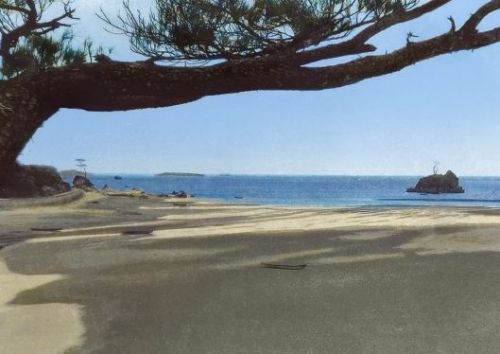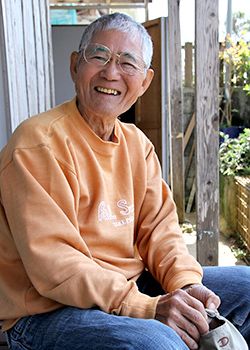Shimabukuro’s photography of 1950’s Henoko sans US base shows changes to his hometown

This is a photograph of Henoko before the construction of Camp Schwab. There were pine trees, and the houses were near the ocean.
March 28, 2019 Ryukyu Shimpo
By Ayako Sakaguchi
Before Camp Schwab was completed there was a large pine tree on Cape Henoko. Takenobu Shimabukuro, 82, who loves photography, has been capturing photographs of his hometown since he was in his 20’s.
His albums are full of old black-and-white photographs. Soil deposits as part of Futenma Replacement Facility (FRF) construction in Henoko, Nago City, are ongoing.
Nowadays the landscapes that have been lost can no longer be seen, and are only kept alive in photographs.
Shimabukuro started photographing his hometown in the 1950’s.
When Camp Schwab was being built he worked as a surveyor.
Henoko was originally an isolated corner of land. In those days there was nothing to eat there.

The photograph was taken in the 1950’s in what was then Henoko, Kushi Village (currently Nago City). (Photograph courtesy of Takenobu Shimabukuro)
Residents would take winding routes into the mountains to barter for food, such as vegetables and rice.
Once the building of Camp Schwab began, construction workers came from all over the island and the population of Henoko grew.
Shimabukuro said, “It was beyond a [population] increase.
I didn’t like it. Naturally, many people rented out their homes.
People lived crammed close together.” Businesses like movie theaters and banks popped up in the settlement of Henoko, in which there were two bus stops.
Life became abundant compared with the era of selling firewood. Shimabukuro went on, “Since there were many jobs, many people came and crowded in.”
A bar district popped up in Henoko, along with over 100 restaurants to accommodate U.S. servicemen. Shimabukuro worked at a dance hall after the completion of Camp Schwab.
He thought back and said, “At that time there were too many foreign people for us to attend to.
Even so, it was fun.”
Although Henoko Ward is thought to have wanted the construction of Camp Schwab back then, Shimabukuro does not think it did.
His words were, “I don’t think [Henoko Ward] would have wanted it.
At that time the U.S. military was building a variety of bases.”
However, even now there are few people in Henoko who repudiate Camp Schwab.
The Camp put Henoko on the map and made it into a bustling community.
In reality, Henoko’s residents also work at restaurants in the Camp and Henoko proper, and Camp Schwab is in the details of Henoko residents’ daily lives.
Even so, Shimabukuro is anxious about the future. Specifically, he is anxious about construction of the FRF in Henoko, and soil deposits moving forward.
Shimabukuro has four sons, and three of the sons’ families no longer live in Henoko.
He explained, “It is noisy here now, so they will not live in Henoko. Truthfully, I would prefer everyone lived nearby.”
It is unknown how life in Henoko will be once the FRF is built.
Shimabukuro said, “I cannot sleep because it is noisy, it would be better if it was quiet.
There was nothing here in those times, but natural living was good. It isn’t clear how many decades it will take [for FRF construction to finish].”
The scenery of Henoko in old photographs lives on in Shimabukuro’s heart.

Takenobu Shimabukuro
(English translation by T&CT and Erin Jones)
Previous Article:Living National Treasure Noho Miyagi first Okinawan to win Japan Art Academy Prize
Next Article:U.S. Osprey from MCAS Futenma makes emergency landing at Osaka International Airport
[Similar Articles]
- Eighty-six-year-old Fumiko Shimabukuro takes a stand in front of Camp Schwab
- Footage of new military base construction captured at Henoko ahead of drone restrictions
- ODB begins soil deposits into new land reclamation section in Henoko at 2:58 p.m. on March 25
- Citizens stage sit-in and canoe protests as K8 seawall construction continues in Henoko
- Government starts building concrete plant at Henoko, Okinawa concerned it will be used for land reclamation
 Webcam(Kokusai Street)
Webcam(Kokusai Street)


